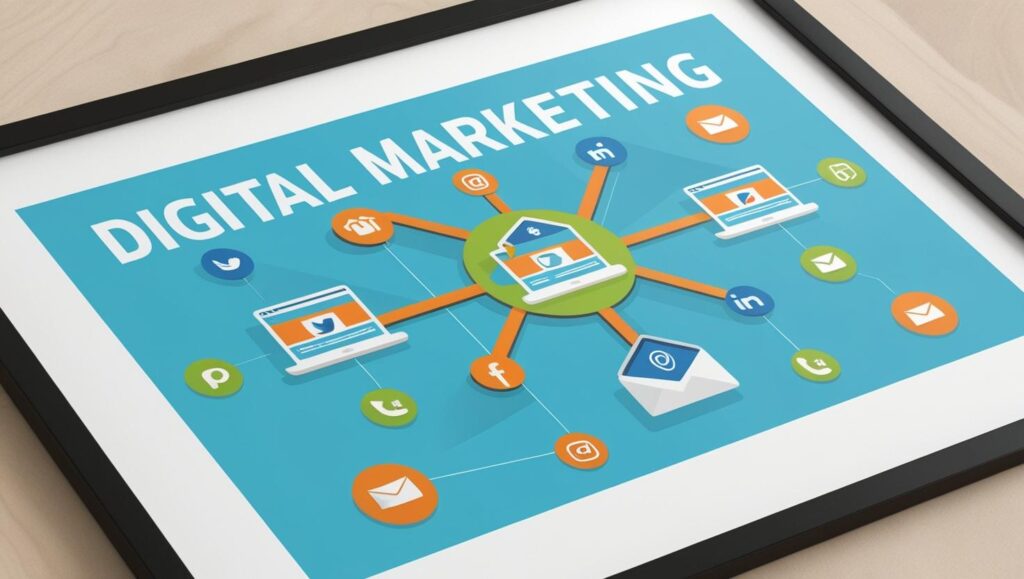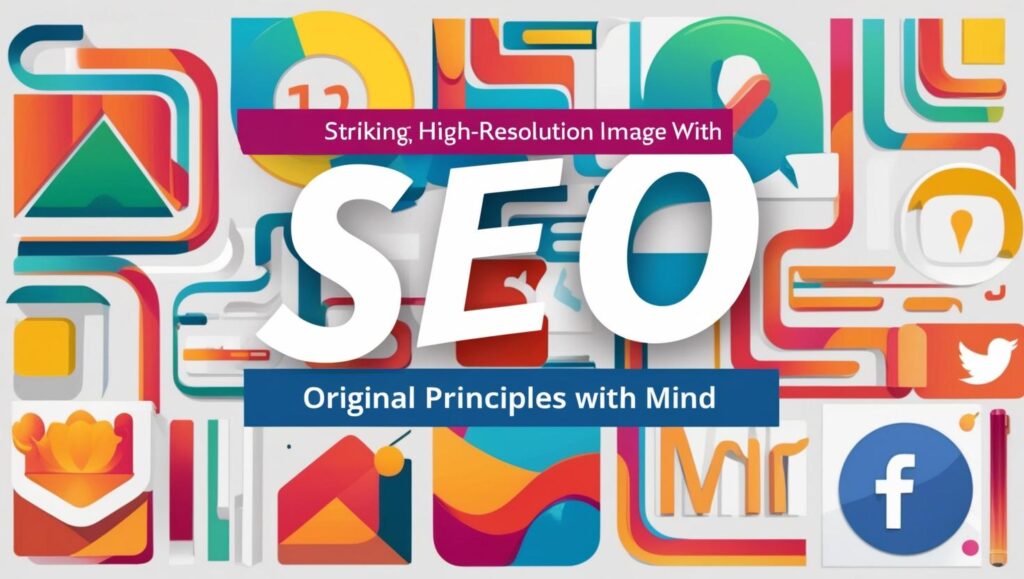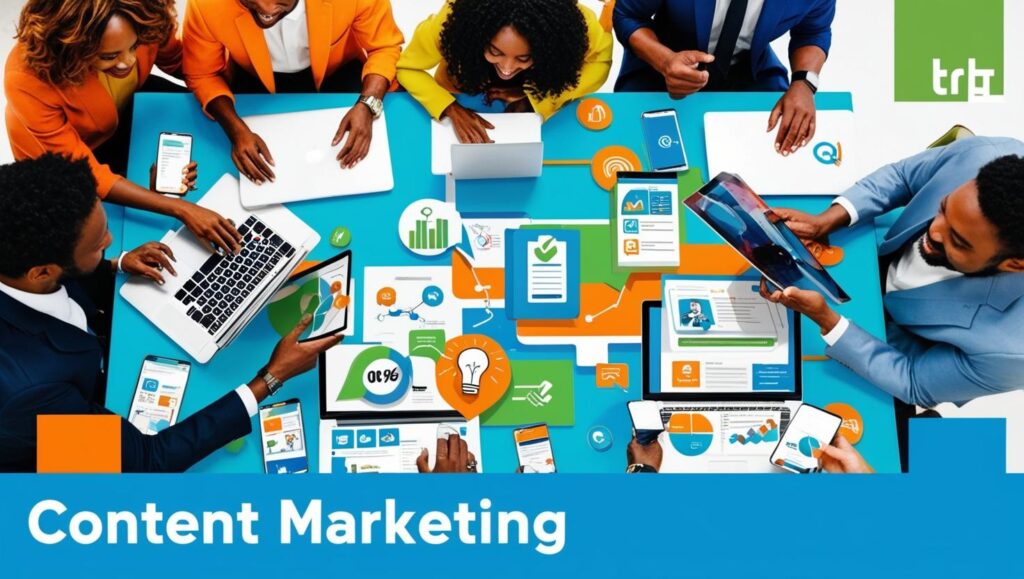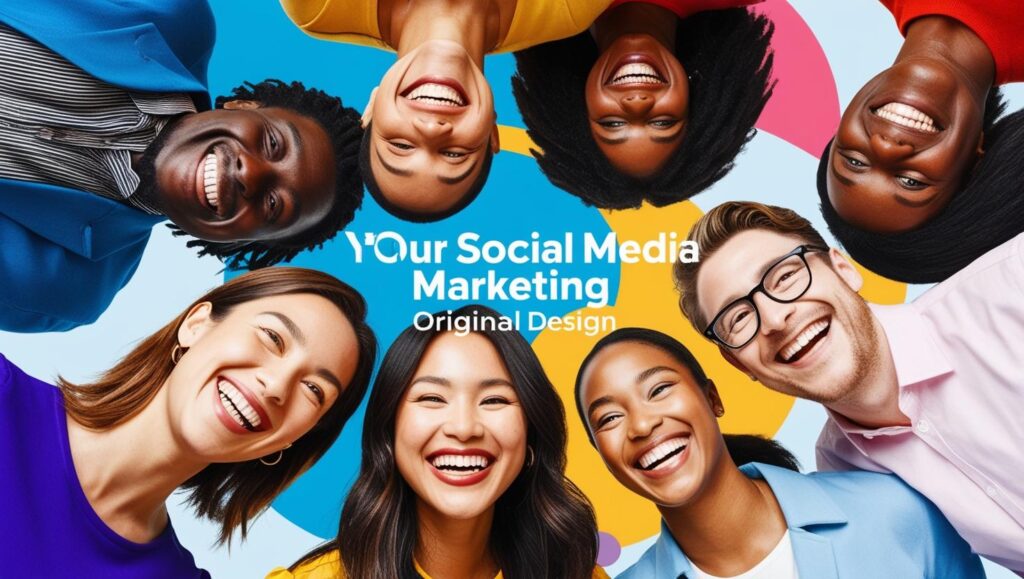
Digital marketing means promoting and selling products or services using the internet. It includes all the ways a business reaches people online, like websites, social media, emails, search engines, and online ads.
For example, when a clothing store posts pictures of new arrivals on Instagram, that’s digital marketing. When you search for “best pizza near me” on Google and see an ad for a pizza place, that’s also digital marketing. Even when you get an email from a store about a sale, that’s part of digital marketing.
The goal of digital marketing is to find people who might be interested in what a business offers and to convince them to visit the website, buy something, or learn more. It helps businesses connect with customers anytime, anywhere, as long as they have internet.
Digital marketing is useful because it’s usually cheaper than traditional marketing, like TV or newspaper ads. It also allows businesses to reach more people, including those from other cities or countries. Plus, it’s easier to track results, like knowing how many people clicked on a link or bought a product.
In simple words, digital marketing is how businesses use the internet to find and talk to customers, grow their brand, and sell their products or services.
Basics of Digital Marketing
Search Engine Optimization (SEO):. It is the process of improving your website so that it ranks higher in search results on Google, Bing, or other search engines. The goal is to get more visitors to your website without paying for ads. It is the practice of optimizing a website to rank higher in search engine results pages (SERPs) to increase organic traffic.

Content Marketing: It is a way of promoting your business by creating and sharing useful content (like articles, videos, or infographics) that helps or entertains people. Instead of directly selling, you provide value to your audience so they trust you and become your customers

Social Media Marketing(SMO): Social media marketing is the use of platforms like Facebook, Instagram, Twitter and LinkedIn to promote a business, product, or service. It involves creating and sharing content such as posts, images, videos, and stories to engage with followers, build brand awareness, and drive traffic or sales. Businesses use social media to connect directly with their audience, respond to messages or comments, and create a loyal community

Email Marketing: Email marketing is a way for businesses to connect with people by sending messages directly to their email inbox. It’s one of the oldest and most effective forms of digital marketing. Companies use email marketing to share news, promote products or services, offer discounts, and build relationships with customers.It helps businesses stay in touch with their audience, build loyalty, and increase sales

Affiliate Marketing: Affiliate marketing is a way to earn money by promoting other people’s products. You share a special link to a product, and if someone clicks your link and buys it, you get a small part of the money as a reward. It’s like getting paid for helping someone sell something. You can share these links on your website, social media, or blog.

- Analytics and Data Analysis: involve collecting, studying, and interpreting data to find useful information and make better decisions. This can help businesses understand things like customer behavior, sales trends, or what’s working and what’s not. By looking at numbers and patterns, people can make smarter choices to improve results and solve problems more effectively.
What is a Digital Marketing Strategy?
A digital marketing strategy is a plan that helps a business use the internet and digital tools (like social media, websites, emails, and search engines) to reach more customers, sell more products, and grow their brand.
Think of it like a roadmap. It tells you:
- What your goals are,
- Where your audience is,
- What digital tools to use,
- And how to measure if your plan is working.
Basic Steps to Create a Digital Marketing Strategy
1. Set Clear Goals: Decide what you want to achieve. Examples:
- Get more website visitors
- Increase online sales
- Get more followers on Instagram
- Build brand awareness
2. Understand Your Audience: Know who your ideal customers are:
- Age, gender, location
- What they like or struggle with
- Where they spend time online
3. Choose the Right Channels: Pick the best platforms to reach your audience:
- Social media (Facebook, Instagram, LinkedIn)
- Search engines (Google – SEO or Google Ads)
- Email marketing
- Your website or blog
- YouTube or other video platforms
4. Create Valuable Content: Make content that your audience finds helpful, interesting, or fun:
- Blog posts
- Videos
- Infographics
- Social media updates
- Ebooks and checklists
5. Use Paid Advertising (if needed):If you want faster results, you can use paid ads:
- Facebook or Instagram Ads
- Google Ads
- YouTube Ads
6. Track Your Results:Use tools like Google Analytics or social media insights to see:
- How many people visited your site
- What content worked best
- How many sales or signups you got
Who Needs Digital Marketing Services?
Anyone who wants to grow their business using the internet can benefit from digital marketing services. Whether you’re a small shop owner or a big company, if your customers are online, you need digital marketing.
Here’s a list of people and businesses that often need digital marketing services:
1. Small Businesses and Startups
They want to get noticed quickly and grow with a small budget.Small businesses usually focus on serving a local market or a specific niche. It can be anything from a local bakery to a small online store.
👉 Digital marketing is affordable and helps reach local or global customers fast.
Example: A new bakery promoting their cakes on Instagram and Google Maps.
2. E-commerce Stores (Online Shops)
They sell products online and need to bring more visitors to their website.
👉 SEO, social media ads, and email marketing help increase sales.
Example: A clothing brand using Facebook ads to promote seasonal sales.
3. Service Providers
It helps or gives expertise to others in exchange for payment. Instead of selling physical products, they provide services like internet access, cleaning, repairs, consulting, or design work. Service providers can work in many industries, such as healthcare, technology, education, or home maintenance.
👉 A good website(digitalazadi.com), Google search ads, and reviews help them get more clients.
Example: A home cleaning service using Google Ads to get local customers.
4. Local Shops
A local shop is a small business that sells goods or services in a specific area, like a neighborhood or town. It could be a grocery store, bakery, clothing shop, or barber. Local shops usually serve nearby residents and often build strong relationships with regular customers. They are important to the community because they provide convenience, personalized service, and support the local economy.
👉 Local SEO and Google Business Profile listings are key.
Example: A gym showing up on Google when people search “gym near me.”
5. Educational Institutions
Such as schools, colleges, universities, coaching centers, online learning platforms, and vocational training centers need digital marketing to stay competitive and relevant in today’s digital landscape. They use digital marketing to increase visibility, attract more students, engage with parents and learners, and build a strong online reputation. With the rise of online education, institutes must reach potential students where they spend most of their time—on digital platforms
👉 Social media, YouTube, and email help promote their classes.
6. Real Estate Agencies
Real estate agencies need digital marketing to effectively promote properties, build brand awareness, and attract potential buyers, sellers, or renters in an increasingly competitive market. Most property searches begin online, so having a strong digital presence is crucial. Digital marketing allows real estate agencies to showcase listings with high-quality images, virtual tours, and detailed descriptions through websites, social media platforms, and listing portals. Strategies like search engine optimization (SEO) help their websites rank higher in search results, while pay-per-click (PPC) ads and social media campaigns can target specific audiences based on location, budget, and preferences. Email marketing keeps past and potential clients engaged with new listings and market updates. Additionally, digital marketing tools provide data insights, enabling agencies to track leads, understand customer behavior, and refine their strategies for better results..
👉 Google Ads, WhatsApp marketing, and video tours on YouTube help attract attention.
7. Doctors, Dentists, and Clinics
Doctors, dentists, and clinics need digital marketing to build trust, attract new patients, and maintain engagement with existing ones. In today’s digital-first environment, patients often search online for healthcare providers, read reviews, and compare services before booking appointments. A strong online presence through a professional website, Google Business Profile, and active social media accounts helps clinics stand out. Digital marketing enables healthcare professionals to educate the public through blogs, videos, and health tips, establishing authority in their field. Search engine optimization (SEO) ensures that the clinic appears in local searches, while paid advertising can target specific demographics in nearby areas. Online appointment booking, patient reviews, and email newsletters also enhance patient experience and retention. Additionally, digital campaigns allow for performance tracking and continuous improvement in outreach and communication efforts.
👉 SEO, reviews, and local listings make it easy for people to find them.
8. Nonprofits and NGOs
Non-profits and NGOs need digital marketing to raise awareness, attract donors, engage volunteers, and promote their causes effectively. In a digital age where people consume content online and make donation decisions through digital platforms, having a strong online presence is essential. Digital marketing allows these organizations to share impactful stories, showcase their work, and build credibility through social media, websites, blogs, and video content. Search engine optimization (SEO) helps their initiatives appear in relevant searches, while social media campaigns can target specific audiences who are most likely to support the cause. Email marketing keeps supporters updated and involved, while crowdfunding and online donation tools streamline fundraising efforts. Paid advertising, even with limited budgets, can be highly effective thanks to grants like Google Ad Grants for NGOs. Overall, digital marketing helps NGOs expand their reach, build meaningful relationships, and create a stronger impact with measurable results.
👉 Social media and email campaigns help spread their message.
9. Influencers and Creators
Influencers and content creators need digital marketing to grow their audience, increase engagement, collaborate with brands, and monetize their content effectively. In a highly competitive digital space, standing out requires more than just posting content—it involves strategic promotion across multiple platforms like Instagram, YouTube and personal websites. Digital marketing helps them build a personal brand through consistent messaging, visual identity, and storytelling. Search engine optimization (SEO) boosts visibility on platforms like YouTube and Google, while social media advertising helps reach targeted demographics and grow followers. Email marketing builds a loyal subscriber base for exclusive content or product launches. Analytics tools allow creators to track performance, understand their audience better, and adjust strategies accordingly. Influencers also use digital marketing to pitch to brands, showcase media kits, and demonstrate their value through engagement metrics and reach. Overall, it’s essential for long-term growth, credibility, and revenue generation.
👉 Social media strategies, SEO for YouTube, and collaborations help increase reach.
10. Large Companies
Large companies need digital marketing to maintain brand dominance, reach global and local markets, engage customers at scale, and stay ahead of competitors. In a rapidly evolving digital landscape, even established brands must continuously communicate their value through multiple online channels. Digital marketing enables them to create personalized customer experiences through data-driven strategies, targeted advertising, and automation. Tactics like search engine marketing (SEM), email campaigns, content marketing, and social media advertising help companies promote products, launch campaigns, and drive conversions efficiently.
👉 They use advanced digital strategies for global marketing, customer support, and brand loyalty.